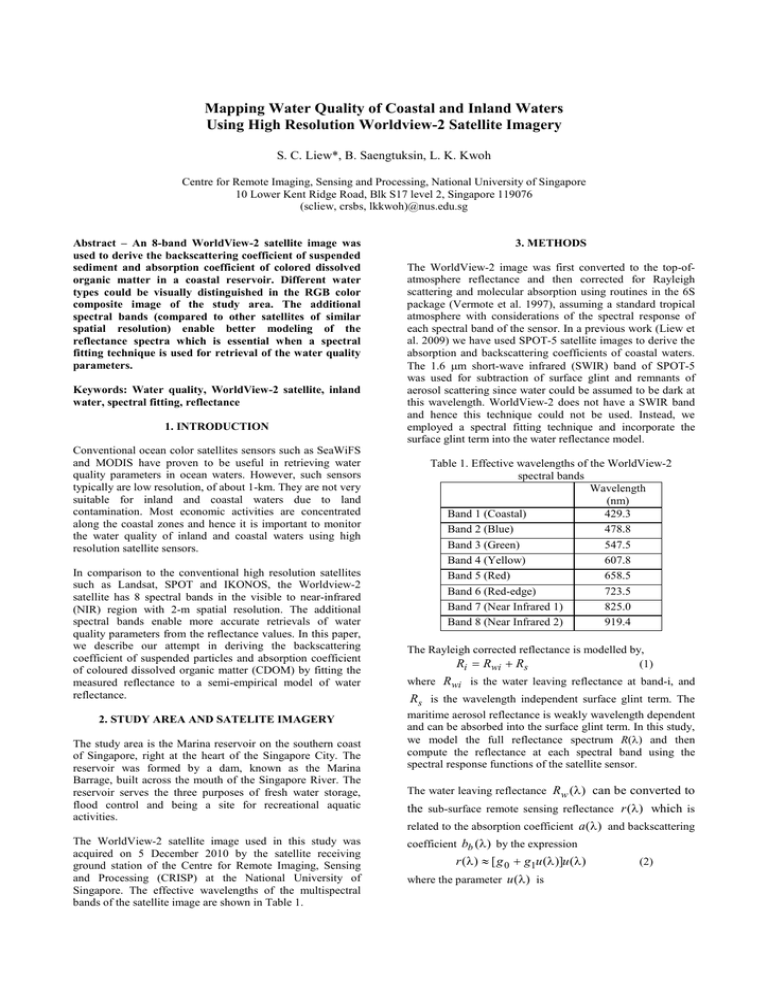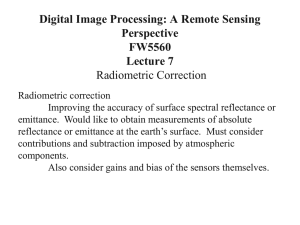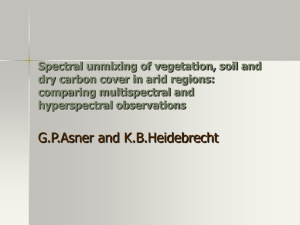Mapping Water Quality of Coastal and Inland Waters
advertisement

Mapping Water Quality of Coastal and Inland Waters Using High Resolution Worldview-2 Satellite Imagery S. C. Liew*, B. Saengtuksin, L. K. Kwoh Centre for Remote Imaging, Sensing and Processing, National University of Singapore 10 Lower Kent Ridge Road, Blk S17 level 2, Singapore 119076 (scliew, crsbs, lkkwoh)@nus.edu.sg Abstract – An 8-band WorldView-2 satellite image was used to derive the backscattering coefficient of suspended sediment and absorption coefficient of colored dissolved organic matter in a coastal reservoir. Different water types could be visually distinguished in the RGB color composite image of the study area. The additional spectral bands (compared to other satellites of similar spatial resolution) enable better modeling of the reflectance spectra which is essential when a spectral fitting technique is used for retrieval of the water quality parameters. Keywords: Water quality, WorldView-2 satellite, inland water, spectral fitting, reflectance 1. INTRODUCTION Conventional ocean color satellites sensors such as SeaWiFS and MODIS have proven to be useful in retrieving water quality parameters in ocean waters. However, such sensors typically are low resolution, of about 1-km. They are not very suitable for inland and coastal waters due to land contamination. Most economic activities are concentrated along the coastal zones and hence it is important to monitor the water quality of inland and coastal waters using high resolution satellite sensors. In comparison to the conventional high resolution satellites such as Landsat, SPOT and IKONOS, the Worldview-2 satellite has 8 spectral bands in the visible to near-infrared (NIR) region with 2-m spatial resolution. The additional spectral bands enable more accurate retrievals of water quality parameters from the reflectance values. In this paper, we describe our attempt in deriving the backscattering coefficient of suspended particles and absorption coefficient of coloured dissolved organic matter (CDOM) by fitting the measured reflectance to a semi-empirical model of water reflectance. 2. STUDY AREA AND SATELITE IMAGERY The study area is the Marina reservoir on the southern coast of Singapore, right at the heart of the Singapore City. The reservoir was formed by a dam, known as the Marina Barrage, built across the mouth of the Singapore River. The reservoir serves the three purposes of fresh water storage, flood control and being a site for recreational aquatic activities. The WorldView-2 satellite image used in this study was acquired on 5 December 2010 by the satellite receiving ground station of the Centre for Remote Imaging, Sensing and Processing (CRISP) at the National University of Singapore. The effective wavelengths of the multispectral bands of the satellite image are shown in Table 1. 3. METHODS The WorldView-2 image was first converted to the top-ofatmosphere reflectance and then corrected for Rayleigh scattering and molecular absorption using routines in the 6S package (Vermote et al. 1997), assuming a standard tropical atmosphere with considerations of the spectral response of each spectral band of the sensor. In a previous work (Liew et al. 2009) we have used SPOT-5 satellite images to derive the absorption and backscattering coefficients of coastal waters. The 1.6 µm short-wave infrared (SWIR) band of SPOT-5 was used for subtraction of surface glint and remnants of aerosol scattering since water could be assumed to be dark at this wavelength. WorldView-2 does not have a SWIR band and hence this technique could not be used. Instead, we employed a spectral fitting technique and incorporate the surface glint term into the water reflectance model. Table 1. Effective wavelengths of the WorldView-2 spectral bands Wavelength (nm) Band 1 (Coastal) 429.3 Band 2 (Blue) 478.8 Band 3 (Green) 547.5 Band 4 (Yellow) 607.8 Band 5 (Red) 658.5 Band 6 (Red-edge) 723.5 Band 7 (Near Infrared 1) 825.0 Band 8 (Near Infrared 2) 919.4 The Rayleigh corrected reflectance is modelled by, Ri = Rwi + Rs (1) where Rwi is the water leaving reflectance at band-i, and Rs is the wavelength independent surface glint term. The maritime aerosol reflectance is weakly wavelength dependent and can be absorbed into the surface glint term. In this study, we model the full reflectance spectrum R(λ) and then compute the reflectance at each spectral band using the spectral response functions of the satellite sensor. The water leaving reflectance Rw (λ ) can be converted to the sub-surface remote sensing reflectance r (λ) which is related to the absorption coefficient a (λ) and backscattering coefficient bb (λ ) by the expression r (λ) ≈ [ g 0 + g1u (λ )]u (λ) where the parameter u (λ) is (2) u (λ ) = bb (λ) a(λ) + bb (λ) (3) and values suggested for high scattering waters for the two coefficients in (2) are used, i.e. g 0 ≈ 0.084, g1 ≈ 0.170 (Lee et al. 1999). The absorption and backscattering coefficients are modelled by a (λ ) = a w (λ) + G exp[− S (λ − 440)] (4) bb (λ) = bbw (λ) + X (550 / λ) y and 9 are near the western side of the reservoir. The values of the particulate backscattering coefficient (X) and CDOM absorption coefficient (G) at these points are tabulated in Table 2. It is seen that both X and G increase along the transect, indicating increasing suspended sediment and CDOM concentrations. Points 9 has low X and G while the sea water at point 1 has the lowest X and G among the 9 points. (5) where a w (λ ) and bbw (λ ) are respectively the absorption and backscattering coefficients of pure water, λ is the wavelength (in nm), G is CDOM absorption coefficient at 440 nm, and X is the particulate backscattering coefficient at 550 nm. The values S = 0.015 nm-1 and y = 0.5 are used. Chlorophyll is assumed to be negligible. In the fitting procedures, the three unknown parameters Rs, G and X are adjusted until the rms difference between the modelled reflectance and the measured reflectance is the minimum. 4. RESULTS Fig. 2. The reflectance spectra of the nine sampling points (1 to 9) indicated in Fig. 1. The blue circles are reflectance derived from satellite data, red circles are modelled reflectance and the red lines are the full reflectance spectra modelled using the best-fit backscattering and absorption coefficients. Fig. 1. RGB composite image of the study area acquired on 5 Dec 2010. The width of the image is about 3 km. The RGB composite image of the study area is shown in Fig. 1. The land area has been masked out in black and the contrast has been heavily stretched to accentuate the colours of the water. The river in the northern part of the image appears bright yellow due to a high suspended sediment load that scatters light. The yellowish colour also indicates the presence of high CDOM that absorbs light in the blue end of the spectrum. The southern and western parts of the reservoir appear reddish brown with relatively low suspended sediment but high dissolved organic matter content. The coastal sea water outside the reservoir has the typical blue-green colour. Fig. 2 shows the 8-band reflectance spectra at nine sampling points indicated in Fig. 1. Point 1 is located at the coastal sea outside the reservoir. Points 2, 4, 5, 6, 7 and 8 trace out a transect going landwards from the Marina Barrage. Points 3 Table 2. The particulate backscattering coefficient at 550 nm (X) and the CDOM absorption coefficient at 440 nm (G) at the 9 sampling points retrieved by the spectral fitting method Sampling point X (m-1) G (m-1) 1 0.029 0.129 2 0.069 0.761 3 0.063 0.640 4 0.124 1.057 5 0.140 1.178 6 0.134 1.131 7 0.205 1.507 8 0.303 2.245 9 0.034 0.453 5. CONCLUSION We have demonstrated the use of the 8-band WorldView-2 satellite imagery in retrieving the particulate backscattering coefficient and CDOM absorption coefficient of coastal and inland waters using the spectral fitting technique. The retrieved values are in agreement with visual interpretation of the colour composite image. The additional spectral bands (compared to other satellite imagery of similar resolution) enable better modelling of the reflectance spectra which is important for robust implementation of the spectral fitting method. E. Vermote, D. Tanre, J. L. Deuze, M. Herman, and J. J. Morcette, “Second simulation of the satellite signal in the solar spectrum: An overview,” IEEE Transactions on Geoscience and Remote Sensing, 35, 675-686, 1997. REFERENCES Z. P. Lee, K. L. Carder, C. D. Mobley, R. G. Steward, and J. S. Patch, “Hyperspectral remote sensing for shallow waters. 2. Deriving bottom depths and water properties by optimization,” Appl. Opt. 38, 3831–3843, 1999. S. C. Liew, B. Saengtuksin, and L. K. Kwoh, “Monitoring turbidity and suspended sediment concentration of coastal and inland waters using satellite data,” IEEE 2009 International Geoscience and Remote Sensing Symposium (IGARSS'09), 13 - 17 July 2009, Cape Town, South Africa. ACKNOWLEDGEMENT The authors acknowledge support from the Agency for Science, Technology and Research (A*STAR) of Singapore in the form of a research grant awarded to the Centre for Remote Imaging, Sensing and Processing (CRISP). S. C. Liew acknowledges support from the Singapore-Delft Water Alliance (SDWA).





